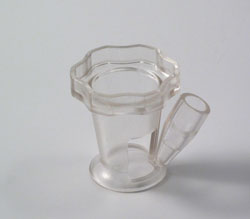Disposable device enables safer, more efficient intravitreal injection
Tool ensures proper injection angle, depth and distance from the limbus. Pressure at the injection site ensures an anesthetic effect, better eye fixation.
 Arnaldo Gonçalves |
A new disposable instrument enhances the safety, accuracy and cost-effectiveness of intravitreal injections, according to the surgeon who invented it.
The InVitria Injection Assistant (FCI Ophthalmics) makes intravitreal injection easier and more efficient for both surgeons and patients, Arnaldo Gonçalves, MD, said.
“[This] device is predictable, safe, patient-friendly, user-friendly and budget-friendly,” Dr. Gonçalves said in an e-mail interview with Ocular Surgery News. “I have treated more than 800 eyes now with the InVitria and I have not found any contraindication or potential risks associated with its use.”
Dr. Gonçalves said he conceived the idea for the device in 2006 and took 2.5 years to develop it through seven prototypes.
“The idea was to have a disposable device that could provide a predictable, easy, safe, comfortable, cheap and fast procedure,” Dr. Gonçalves said. “At that time, I was one of the few ophthalmologists in Holland who had pioneered age-related macular degeneration treatment through the intravitreal injection of anti-VEGF.”
Safety, efficiency and comfort
The device streamlines the injection procedure by eliminating the need for other instruments such as a speculum, caliper or pressure plate, Dr. Gonçalves said. The improved ergonomics help take some of the risk out of intravitreal injection and reduce patient anxiety related to eye injections, he said.
The procedure of the traditional treatment is not difficult, Dr. Gonçalves said, but most patients are uncomfortable with the idea of getting an injection in the eye.
“In fact, it has become much easier to treat very anxious patients who have the tendency to abruptly move the eyes or close the eyes in spasm,” he said. “Patients are more confident in the treatment and less reluctant in the repeated character of the treatment because they have no pain.”
The device enables fast, safe and efficient intravitreal injection, Dr. Gonçalves said.
|
Image: Goncalves A |
“The logistics around the traditional treatment are, in a certain way, inefficient,” he said. For example, the conventional surgical set must be unpacked, stored and sterilized after use, Dr. Gonçalves said, which consumes valuable time and resources in a high-volume hospital.
At about $10 per procedure, the device is far more cost-effective than the traditional intravitreal injection method, Dr. Gonçalves said. Accounting for initial cost of the materials, sterilization, and replacement of old and lost materials, the total cost per procedure of the traditional method or with the disposable sets available at the moment is between $20 and $25, he said.
The InVitria Injection Assistant is made of Makrolon 2458 and is available sterilized in boxes of 25, according to a product brochure.
FCI Ophthalmics is the exclusive distributor of the InVitria Injection Assistant in the United States.
Easy positioning and fixation
The InVitria Injection Assistant is easy to center and fixate on the eye, Dr. Gonçalves said, with almost no learning curve needed.
The physician places the device on the patient’s eye, guided by a positioning line that is aligned with the limbus. The physician fixates the eye by gently pushing the device down and turning it. The turning displaces the conjunctiva, creating an anesthetic effect and a stepped injection hole that prevents leakage of aqueous fluid.
“Visualization of the orientation line is possible due the central opening of the InVitria,” Dr. Gonçalves said. “Corneal size does not matter, because the positioning of the InVitria does not depend on the center or the size of the cornea.”
With the eye immobilized and the patient unable to see the needle, the physician gently places the needle through a guide tube that ensures optimal injection angle, depth and distance from the limbus. The injection site is always 3.5 mm from the positioning line. The guide tube is fixed at a 28° angle, and injection depth is fixed at 5.6 mm.
Dr. Gonçalves said he formerly used 25-, 27- and 30-gauge needles in conjunction with the InVitria device but now uses only 30-gauge instrumentation for superior comfort.
Turning the device back after removing the needle returns the displaced conjunctiva over the point of injection to prevent aqueous fluid leakage. – by Matt Hasson

- Arnaldo Gonçalves, MD, can be reached at St. Anna Ziekenhuis Hospital, Bogardeind 2, 5664 EH Geldrop, the Netherlands; 31-40-286-4374; or St. Jans Gasthuis Hospital,Vogelsbleek 5, 6001 BE Weert, the Netherlands; 31-49-557-2171; e-mail: arnaldo_goncalves@hotmail.com. Dr. Gonçalves is the owner of the product patent for the InVitria Injection Assistant.

